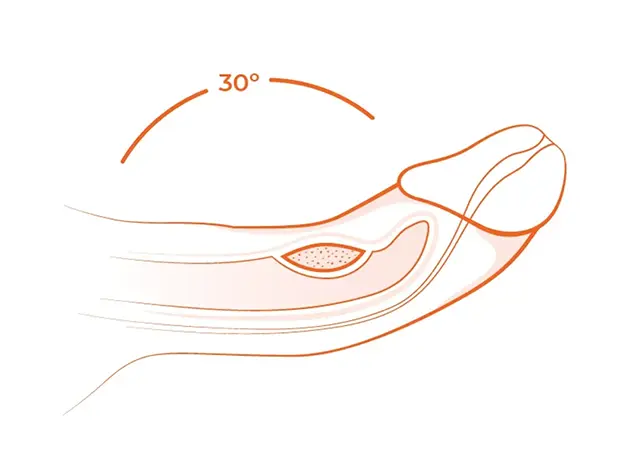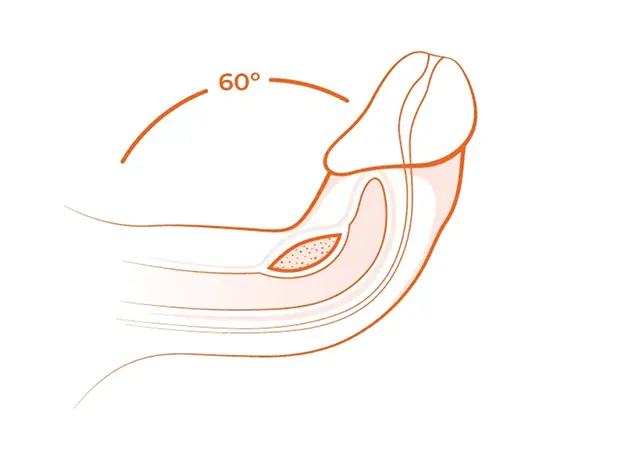Peyronie’s Disease (PD)
Is it normal to have a bend with a bump in my penis?Some bends are normal, but some are not
Every man’s penis is different.
They vary in size and shape. It might even be normal for men to have a slight bend in their penis. But if you notice a significant bend with a bump that forms when your penis is erect, it's time to ask a Urology Specialist if it could be PD.
What is Peyronie’s disease (PD)?
PD is a medical condition that involves a buildup of scar tissue under the skin of the penis, causing an abnormal curve in your erection that can be felt. This curve may result in pain during intimacy or arousal. PD is a treatable condition, and it may be more common than you think.

Learn more about how PD is treated and talk to a Urology Specialist to see what treatment options may be right for you.
PD can look different for everyone
Erectile curvature: what you need to know
Erectile curvature can vary greatly from one person to another. A member of your urology care team can discuss what treatment options are best for you depending on your degree of erectile curvature.
Degrees of erectile curvature
Take a look at various degrees of erectile curvature associated with PD.
15°
30°

60°

90°
Understanding PD
Find out more about PD and how XIAFLEX may help treat it.
Important Safety Information
Do not receive XIAFLEX if:
- the Peyronie’s plaque to be treated involves the “tube” that your urine passes through (urethra).
- you are allergic to collagenase clostridium histolyticum or any of the ingredients in XIAFLEX, or to any other collagenase product. See the end of the Medication Guide for a complete list of ingredients in XIAFLEX.
XIAFLEX can cause serious side effects, including:
- Penile fracture (corporal rupture) or other serious injury to the penis. Receiving an injection of XIAFLEX may cause damage to the tubes in your penis called the corpora. After treatment with XIAFLEX, one of these tubes may break during an erection. This is called a corporal rupture or penile fracture. This could require surgery to fix the damaged area. Damage to your penis might not get better after a corporal rupture.
- After treatment with XIAFLEX, blood vessels in your penis may also break, causing blood to collect under the skin (hematoma). This could require a procedure to drain the blood from under the skin. If a hematoma appears, skin and soft tissue necrosis (death of skin cells) may develop in that area, which could require surgery.
Symptoms of corporal rupture or other serious injury to your penis may include:
- a popping sound or sensation in an erect penis
- sudden loss of the ability to maintain an erection
- pain in your penis
- purple bruising and swelling of your penis
- difficulty urinating or blood in the urine
Call your healthcare provider right away if you have any of the symptoms of corporal rupture or serious injury to the penis listed above.
Do not have sex or any other sexual activity between the first and second injections of a treatment cycle.
Do not have sex or have any other sexual activity for at least 4 weeks after the second injection of a treatment cycle with XIAFLEX and after any pain and swelling has gone away.
XIAFLEX for the treatment of Peyronie’s disease is only available through a restricted program called the XIAFLEX Risk Evaluation and Mitigation Strategy (REMS) Program.
Hypersensitivity reactions, including anaphylaxis. Severe allergic reactions can happen in people who receive XIAFLEX, because it contains foreign proteins.
Call your healthcare provider right away if you have any of these symptoms of an allergic reaction after an injection of XIAFLEX:
- hives
- swollen face
- breathing trouble
- chest pain
- low blood pressure
- dizziness or fainting
Back pain reactions. After receiving an injection of XIAFLEX for Peyronie’s disease, you may suddenly feel back pain, including severe lower back pain moving to your legs, feet, chest and arms. The back pain may also include spasms and make it hard to walk. These symptoms usually go away in 15 minutes or less, but may last longer.
Tell your healthcare provider right away if you have sudden back pain, chest pain, or hard time walking after an injection.
Fainting. Fainting (passing out) or near fainting can happen in men who receive XIAFLEX, especially if they have severe penile pain.
If you have dizziness or feel faint after receiving XIAFLEX, lie down until the symptoms go away.
Before receiving XIAFLEX, tell your healthcare provider if you have had an allergic reaction to a previous XIAFLEX injection, have a bleeding problem, received XIAFLEX for another condition, or any other medical conditions. Tell your healthcare provider about all the medicines you take, including prescription and over-the-counter medicines, vitamins, and herbal supplements. Using XIAFLEX with certain other medicines can cause serious side effects. Especially tell your healthcare provider if you take medicines to thin your blood (anticoagulants). If you are told to stop taking a blood thinner before your XIAFLEX injection, your healthcare provider should tell you when to restart the blood thinner. Ask your healthcare provider or pharmacist for a list of these medicines, if you are not sure.
What should I avoid while receiving XIAFLEX?
Avoid situations that may cause you to strain your stomach (abdominal) muscles, such as straining during bowel movements.
Do not use a vacuum erection device during your treatment with XIAFLEX.
XIAFLEX can cause serious side effects, including increased chance of bleeding. Bleeding or bruising at the injection site can happen in people who receive XIAFLEX. Talk to your healthcare provider if you have a problem with your blood clotting. XIAFLEX may not be right for you.
The most common side effects with XIAFLEX for the treatment of Peyronie’s disease include:
- a small collection of blood under the skin at the injection site (hematoma)
- swelling at the injection site or along your penis
- pain or tenderness at the injection site, along your penis and above your penis
- penis bruising
- itching of your penis or scrotum (genitals)
- painful erection
- erection problems (erectile dysfunction)
- changes in the color of the skin of your penis
- blisters at the injection site
- pain with sex
- a lump at the injection site (nodule)
Tell your healthcare provider if you have any side effect that bothers you or does not go away.
These are not all of the possible side effects with XIAFLEX. For more information, ask your healthcare provider or pharmacist. You may report side effects to FDA at 1-800-FDA-1088.

